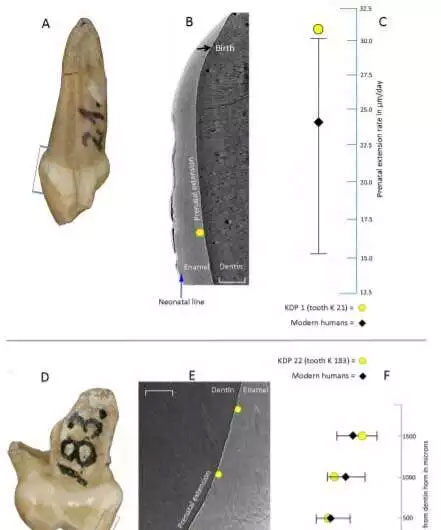Another shocking characteristic of Neanderthals – our extinct “cousins” – has been revealed through the remains of a child who lived in Croatia 120,000 years ago.
Most Neanderthal human remains are fragmented, but scientists were fortunate to find a well-preserved milk tooth from a stillborn child at a site in Krapina, Croatia.
Surprisingly, analysis of the tooth indicates it belonged to a baby approximately 4 months old, or at most 7 months old, but fully developed, suggesting that it had started to grow considerably earlier, according to the Daily Mail.

The incisors of the Neanderthal child indicate it developed earlier than the incisors of modern human children by 4 months – Photo: Proceedings of The Royal Society B
For modern humans, Homo sapiens, the age at which children typically get their first milk teeth is between 6 to 12 months. However, according to a publication in the Proceedings of The Royal Society B on this remarkable discovery, Neanderthal children sprouted teeth an average of 4 months earlier than modern humans.
According to Phys.org, the description from the international research team led by Dr. Patrick Mahoney from the University of Kent (USA) indicates that the 4-month-old Neanderthal child was fully capable of sharing meals with its parents, including meat, vegetables, grains, and more. This astonishing early development was necessary to ensure enough energy to nourish their large brains.
Previous studies have shown that Neanderthal brains were significantly larger than those of other species within the genus Homo, including our own modern Homo sapiens. Evidence also suggests they were “superhumans” with robust bodies akin to rugby players, swimming like mermaids, skilled hunters, and possessed many abilities such as spinning fibers and weaving nets that may have developed even earlier than in humans.
However, this does not mean that Neanderthals were smarter than modern humans, as their brains and those of other Homo relatives lacked many specific genes that determine the ability to organize tightly-knit societies and high adaptability—traits that have enabled the development of modern civilizations and helped Homo sapiens survive major global disasters.
Neanderthals went extinct approximately 30,000 to 40,000 years ago, with the cause believed to be due to severe changes in the Earth combined with the “invasion” of modern humans.


















































